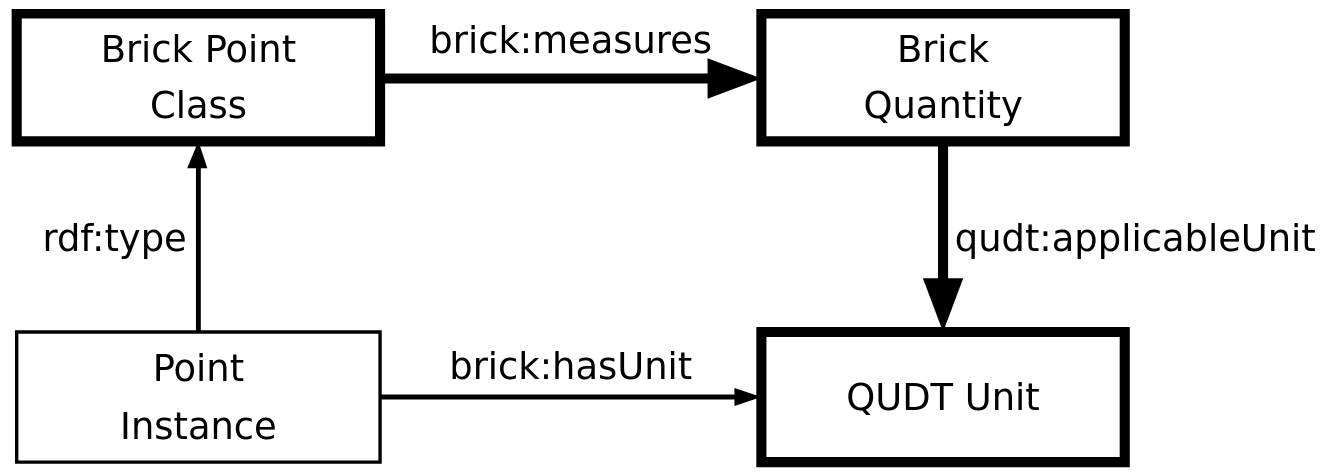Modeling Data Sources
Contents
Modeling Data Sources#
Brick models describe data sources and their context — what they are, where they are, what they mean, and how they relate to the building processes and structures that contain them. Because Brick models are only a means of describing data sources, we also need a way of representing the data itself. This document describes how to effectively describe timeseries data — stored in an external database — using the Brick ontology.
Specifically, this document covers:
common design patterns for describing timeseries data with Brick
using and verifying units of measure for timeseries data
This document assumes familiarity with the Relationships documentation.
For information on how to link timeseries data in Brick to a database, see the timeseries storage documentation.
Here is the high-level description of the Brick data model for telemetry. Boxes represent entities; edges represent relationships. Bolded items are defined by the Brick ontology and do not need to be defined in a Brick model for a particular building.

Categorizing Data Sources#
Instances of the Brick Point class represent sources or sinks of telemetry. There are several major classes of telemetry in Brick:
Sensor: represents the value of a device or instrument designed to detect and measure a variableSetpoint: represents the value at which the desired property is setAlarm: represents signals that alert an operator to an off-normal condition which requires some form of corrective actionCommand: represents settings/actions that directly determines the behavior of equipment and/or affects relevant operational points.Parameter: represents configuration settings used to guide the operation of equipment and control systems; for example they may provide bounds on valid setpoint valuesStatus: represents the current operating mode, state, position, or condition of an item. Statuses are observations and should be considered ‘read-only’
Each of these classes is the root of a class hierarchy of more specific point types. See the Brick documentation for details. To observe documentation for any Brick class, simply navigate to the Brick class URL in your browser. For example, the Brick class brick:Air_Temperature_Sensor is short for https://brickschema.org/schema/Brick#Air_Temperature_Sensor; navigating to that link will open a web page with the documentation describing that class.
Point Instances#
A single data source — a particular sensor channel, setpoint, and so on — is realized in a Brick model as an instance of a Point class. An instance is represented by a URI, typically in a namespace specific to the deployment site, which is related to a Brick Point class by means of the rdf:type relationship.
The snippet below defines a zone air temperature sensor named mybldg:t1 in two equivalent ways.
@prefix brick: <https://brickschema.org/schema/Brick#> .
@prefix rdf: <http://www.w3.org/1999/02/22-rdf-syntax-ns#> .
@prefix mybldg: <mybuilding#> .
mybldg:t1 rdf:type brick:Air_Temperature_Sensor .
# 'a' is a common and universally recognized shorthand for 'rdf:type'
mybldg:t1 a brick:Air_Temperature_Sensor .
An instance is commonly related to locations and/or equipment by means of the brick:isPointOf relationship, though these annotations are optional:
@prefix brick: <https://brickschema.org/schema/Brick#> .
@prefix rdf: <http://www.w3.org/1999/02/22-rdf-syntax-ns#> .
@prefix mybldg: <mybuilding#> .
mybldg:t1 a brick:Air_Temperature_Sensor .
mybldg:tstat1 a brick:Thermostat ;
brick:hasPoint mybldg:t1 .
# instead of the `brick:hasPoint` line above, we could have written
mybldg:t1 brick:isPointOf mybldg:tstat1 .
Points cannot have locations (they are not physical entities), but they can be related to locations through the brick:isPointOf relationship.
We can associate the Point with an equipment, and then place the equipment in a location. For example, the following snippet associates a temperature sensor with a thermostat, and then places the thermostat in a room:
@prefix brick: <https://brickschema.org/schema/Brick#> .
@prefix rdf: <http://www.w3.org/1999/02/22-rdf-syntax-ns#> .
@prefix mybldg: <mybuilding#> .
mybldg:t1 a brick:Air_Temperature_Sensor .
mybldg:tstat1 a brick:Thermostat ;
brick:hasPoint mybldg:t1 .
mybldg:room1 a brick:Room ;
brick:isLocationOf mybldg:tstat1 . # the thermostat, not the sensor!
An instance can have many other properties attached to it, including units of measure as we will see in the next section.
Units of Measure#
Note
A list of available units can be found here
An important piece of metadata to capture is the units of measure for a particular data stream. Brick builds on the QUDT ontology, which provides formal, semantic definitions of many common units. We have done some work to try and simplify the data model for the common cases, but there are some situations for which the necessary complexity comes through. We will point out those “sharp corners” in the documentation where they arise.
Units of measures are instances of the qudt:Unit class, and are represented by URIs such as unit:DEG_F and unit:PPM. Units are associated with Brick Points with the brick:hasUnit relationship:
@prefix brick: <https://brickschema.org/schema/Brick#> .
@prefix rdf: <http://www.w3.org/1999/02/22-rdf-syntax-ns#> .
@prefix unit: <http://qudt.org/vocab/unit/> .
@prefix mybldg: <mybuilding#> .
mybldg:t1 a brick:Air_Temperature_Sensor ;
brick:hasUnit unit:DEG_F .
A list of available units can be found here. Given a Brick Point instance, it is possible to query for valid potential units. The ?unit values returned by this query can be associated with a Point instance using the brick:hasUnit relationship as seen above.
PREFIX brick: <https://brickschema.org/schema/Brick#> .
PREFIX qudt: <http://qudt.org/schema/qudt/> .
SELECT ?unit WHERE {
mybldg:t1 brick:measures/qudt:applicableUnit ?unit .
}
Some QUDT units have symbols associated with them; these can be retrieved through altering the above query:
SELECT ?unit ?symbol WHERE {
mybldg:t1 brick:measures/qudt:applicableUnit ?unit .
OPTIONAL {
?unit qudt:symbol ?symbol
}
}
Note
Most QUDT units have labels, which are human readable strings denoting the units. These may be a helpful alternative to qudt:symbol for rendering what units are associated with a point. These can be retrieved using the following query:
SELECT ?unit ?label WHERE {
mybldg:t1 brick:measures/qudt:applicableUnit ?unit .
?unit rdfs:label ?label
}
Points, Quantities and Units#
Warning
Section coming

